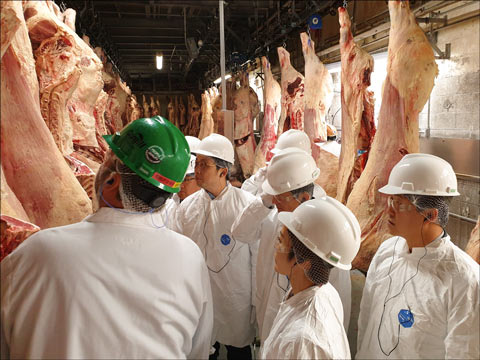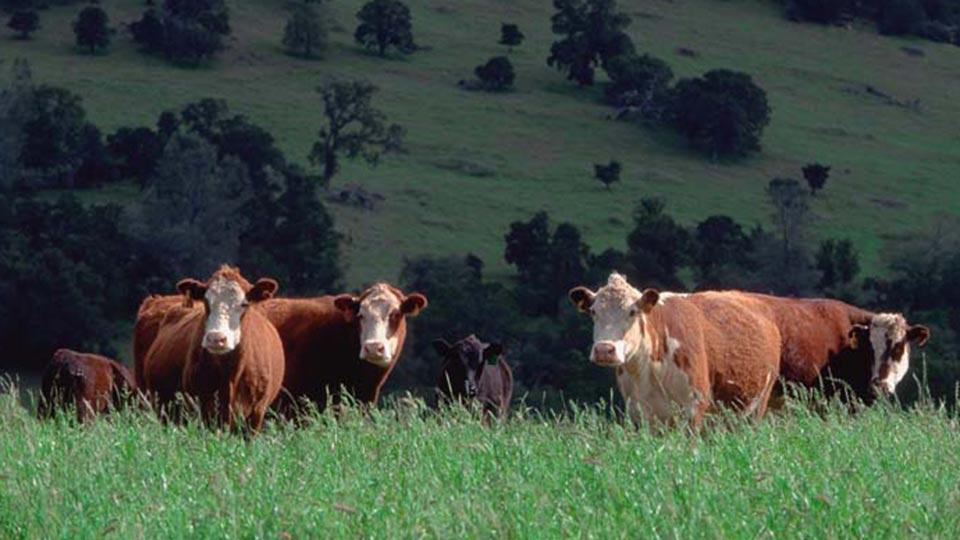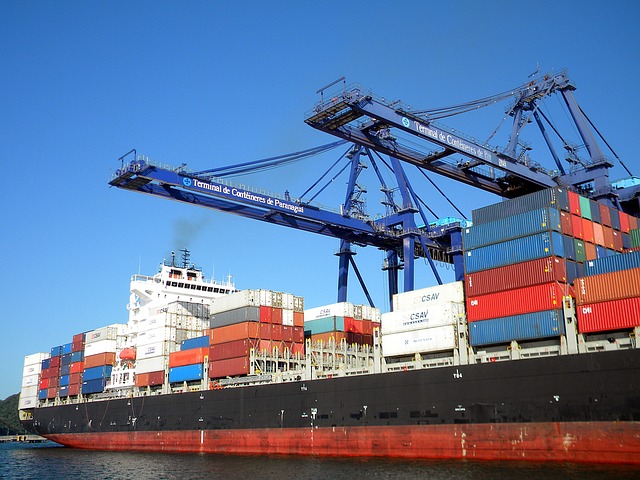



Weekly beef and dairy digest: China continues to drive global meat consumption as global beef production expands
China's appetite for beef keeps the industry on track, and the USDA publishes its analysis of Spain's cattle sector.China continues to drive red meat trade
China beef imports and its share of global trade are expected to grow for the eighth consecutive year in 2022.
Beef gained ground as China struggled with tight pork supplies over the past several years. Evolving consumer preferences and an improving foodservice environment will give beef a larger place in the Chinese diet than in the past while muted growth in domestic production will support imports.

Global beef and veal production seen up in 2022
Global production of beef and veal is forecast up nearly 1% in 2022 on growth in Australia, Brazil, and India, said USDA in a report. Australia production is expected to rebound 8% as improved pasture conditions have spurred herd rebuilding.
Beef production will be driven by higher supplies of slaughter-ready cattle next year and an increase in carcass weights driven by a higher rate of male slaughter. Meanwhile, beef production in Brazil is expected to be supported by greater cattle availability and improved margins for slaughterhouses. In India, carabeef production will continue the recovery that began in 2021 after severe supply chain disruptions caused a sharp drop in production during 2020.
Global exports in 2022 are forecast 2% higher due to expectations of continued strong global demand, particularly from Asia. Australia is expected to have higher exports on rebounding production, particularly in the second half of 2022.

Meanwhile, Brazil exports are expected to be record large as demand continues to grow in top market China. In contrast, New Zealand exports will be constrained by tighter cattle supplies. Paraguay will likewise see exports contract as harsh weather this year led cattle to be marketed earlier than planned and will reduce availability in 2022. Despite the decline, Paraguay is still expected to achieve its second-highest export total on record.
US production and exports
Production for 2022 is forecast down 3% as tighter cattle supplies weigh on slaughter. Tightening US beef supplies are expected to constrain exports, which are forecast 4% lower year-over-year. Meanwhile, production recovery in Australia is expected to increase competition in key Asian markets. However, US exports are expected to remain elevated by historical standards, achieving the second-highest total on record.
China bans beef imports from the UK after BSE detection
China’s customs office has banned the import of British beef from cattle under 30 months of age due to a case of bovine spongiform encephalopathy (BSE) in the country during September. The ban took effect 29 September. The ban will have little impact as China had yet to restart purchases of British beef after agreeing in 2019 to lift a ban on its beef stemming from BSE cases in the 1990s.

Exports continue to drive Spain livestock markets
The Spanish livestock sector's strategy is now focused on a more controlled expansion and diversification of export markets, says USDA in a report. The overall Spanish meat sector, including cattle and swine, is willing to invest around $4.2 billion USD, partially through the European Union (EU) Next Generation funds, to improve animal welfare, sustainability, efficiency, and modernize the sector.
To reach these goals, the sector will invest in technology and smart farming to increase workers’ well-being and add value to the animal production chain from the ranch to the table through promotional campaigns. The Spanish meat sector is committed to sustainability, rural development, and the Spanish economic recovery after the pandemic.
Throughout the country, two million people depend on the livestock-meat industry for their livelihood, mainly in rural areas that are the most affected by depopulation. Spanish livestock production contributes to more than $17 billion to the country’s agricultural production, while Spain’s meat industry has a turnover of more than $30 billion. This represents 22.6% of the total Spanish food industry, making it the leading sector with exports of $10.4 billion.
The increase of Spanish live cattle exports to North Africa and Middle East and the opening of new markets for Spanish beef partly alleviated the difficulties derived from the closure of the hospitality sector during the COVID-19 pandemic. However, Spanish cattle growers are still facing challenges, namely higher feed costs and energy, that are not reflected in the farm-gate prices of their animals.

Weekly USDA US milk market report
- Butter: Grade AA closed at $1.7200. The weekly average for Grade AA is $1.6990 (-0.0545).
- Cheese: Barrels closed at $1.7900 and 40# blocks at $1.8100. The weekly average for barrels is $1.7855 (+0.0945) and blocks, $1.8065 (+0.0095).
- Non-fat dry milk: Grade A closed at $1.4600. The weekly average for Grade A is $1.4300 (+0.0500).
- Dry whey: Extra grade dry whey closed at $0.5950. The weekly average for dry whey is $0.5915 (+0.0130).
Cheese highlights
Cheese demand notes, for the most part, are positive. Asian interests remain steadfast, but shipping backups/costs have become the new normal from Western contacts. Cheese inventories vary from region to region. Spot milk loads were discounted from $1.25 to $.25 below Class III this week.
A number of cheese plant contacts relayed plant updating/maintenance was scheduled this week, so there were some extra loads of milk moving throughout the networks. Labor shortages continue to create issues for plant schedules. Some plant managers have said despite staffing shortages, they are still running seven days per week.
Cheese market tones are settling a bit after last week's runup. After months of what contacts consider a large price gap between blocks and barrels on the CME, the difference has receded to less than a dime this week, which most contacts concur is a bullish, or at least a stabilizing, factor for near term cheese markets.

Butter highlights
Cream is tighter but available. Some Central butter makers are sourcing cream out of the West as local supplies are more costly. Production at some butter plants is hampered by staffing shortages and trucking issues. Hiring is said to be improving, but training new employees takes time. While not yet impacting production, some butter manufacturers are also facing lengthy delays in receiving packaging supply orders.
Butter inventories are stable for near term needs. Food service orders are mixed. Restaurant sector demand is taking a dip in some areas experiencing dine-in/service restrictions or increasing COVID case numbers. Retail sales are steady to higher. Increasing numbers of grocers are featuring butter advertisements. Bulk butter overages range from 1 to 8.50 cents above market this week.
Fluid milk
Cows are comfortable in cooler fall temps, and farm level milk production is increasing in many areas. Class I sales are generally steady to higher throughout the country. In the Southeast, where output is leveling off and bottling orders are heavy, milk loads are short for all processing needs. Midwestern cheesemakers report discounted spot milk prices from $1.25 to $0.25 under Class III.
Some eggnog production has begun in the Pacific Northwest. As plants nationwide prepare for holiday production runs, some milk loads have been reallocated to accommodate scheduled maintenance downtime. Condensed skim has a stable undertone; contracts are steady and manufacturer supplies are in good balance with buyer demands. Some cream end users are less active than anticipated ahead of the fall season. Short staffing has impacted some butter plant production schedules, but hiring numbers are reportedly beginning to improve. Limited driver availability continues to discombobulate hauling. FOB cream multiples for all classes are 1.32-1.46 in the East, 1.30-1.36 in the Midwest, and 1.11-1.35 in the West.
.jpg)
Dry products
The low/medium heat non-fat dry milk (NDM) price range narrowed in the Central and East but widened in the West. Mostly ranges for low/medium heat NDM in all regions shifted up. Inventories are more available in the West than elsewhere. Demand is strong in both export and domestic markets. High heat NDM prices increased in the West but are mixed in the Central and East. Light seasonal demand is reported, but high heat availability and production are limited.
The Central and East dry buttermilk price range is stable. Western dry buttermilk range prices are steady at the top and higher at the bottom; the mostly range is unchanged. Domestic demand is tapering seasonally, but international demand, especially out of Mexico, is steady. The dry whole milk price range is holding steady. Limited production has resulted in less availability. While spot trading is currently quiet, demand is expected to pick up in the coming weeks.
Dry whey prices are steady to higher in all regions. The mostly range did not change in the West but increased in the Central. Production and availability vary. Export interest is strong. The bottom of the whey protein concentrate (WPC) 34% price range jumped up. Some manufacturers report increased inquiries as shoppers look to WPC 34% for a possible substitute as NDM and other dairy protein prices increase. Inventories are tighter.
The lactose price range shifted down and the bottom of the mostly dropped. Shipping ability is said to be a major pricing factor. Transportation and shipping supply snags have contributed to a backlog of shipments. Inventories are heavy but largely committed. Prices are unchanged for acid casein and rennet casein.

Organic dairy market news
A national organic dairy cooperator's October 2021 pay price, per cwt., is $29.24. The organic milk pay price received by organic dairy producers is based on the geographic area where the milk is produced, with a twelve-month average price of $31.55, based on a 12.9% representation of total solids. The July 2021 organic milk pay price in Europe adjusted higher over the previous month in France and Austria but declined in Germany and Bavaria.
This week, organic feed corn trade activity is moderate on moderate to good demand. Organic feed soybean trade is light to moderate on very good demand. Spot market trades were too limited to report for organic feed wheat, while the market notes a firm undertone.
National retail report
Conventional ice cream in 48-to-64-ounce containers remains the most advertised dairy item across the country, but ads declined 4% from the previous period. Conventional yogurt ad numbers decreased 20% as organic yogurt ads declined 8%.

Conventional Greek yogurt in 4 to 6 ounce containers show a weighted average price of $.93, which is down 3 cents from last week. Conventional cheese ad numbers decreased 10%. The weighted average advertised price for conventional 8-ounce shred cheese is $2.44, down 1 cent from last week. Conventional 8-ounce shred cheese was the most advertised cheese item.
Total conventional milk ads decreased 30%, while organic milk ads decreased 3% compared to the advertisement numbers from last week. The national weighted average advertised price for conventional milk half gallons is $2.18, compared to $3.90 for organic milk half gallons, an organic price premium of $1.72.
TheCattleSite News Desk
IMPORTANT NOTE: I am not a futures broker and do not manage any trading accounts other than my own personal account. It is my goal to point out to you potential trading opportunities. However, it is up to you to: (1) decide when and if you want to initiate any traders and (2) determine the size of any trades you may initiate. Any trades I discuss are hypothetical in nature.
Here is what the Commodity Futures Trading Commission (CFTC) has said about futures trading (and I agree 100%): 1. Trading commodity futures and options is not for everyone. IT IS A VOLATILE, COMPLEX AND RISKY BUSINESS. Before you invest any money in futures or options contracts, you should consider your financial experience, goals and financial resources, and know how much you can afford to lose above and beyond your initial payment to a broker. You should understand commodity futures and options contracts and your obligations in entering into those contracts. You should understand your exposure to risk and other aspects of trading by thoroughly reviewing the risk disclosure documents your broker is required to give you.



